We now resume our interrupted broadcast of our travels from Spain. It was just two weeks ago that our three brave heroes found themselves in the capital of Catalonia…
The road to Barcelona is well-trodden, and every tour of the city includes its iconic monuments to Antoni Gaudi, the well-known Spanish Catalan architect. This might as well be the city of Gaudi, we had to conclude after three days of wandering around. Our first stop was Park Guell, on a hill in the north of Barcelona that affords a picturesque view of the city. Gaudi designed and built the park in 1914, and it has come to be known for his signature touch of modernist and naturalist architecture, built of strange, organic shapes and encrusted with mosaics. The winding park terrace which is also covered with mosaics are well-known to me, and recall to me the films like L’auberge espagnole and Vicky Cristina Barcelona where I first saw them.

For the record, though, our visit to the park was slightly disappointing because the most notable parts of the park were roped off for paying visitors who had the patience to wait two hours in line or the foresight to purchase tickets online. Instead, we simply looked on from further away and wandered the free areas of the park. Those didn’t exactly give a stress-free experience, however, as vendors selling water, mosaic-keychains, scarves, and every other kind of touristy knick-knack were everywhere. Just hearing someone repeatedly mumble “Water -one euro, water – one euro” gave me nasty flashbacks to New Delhi.
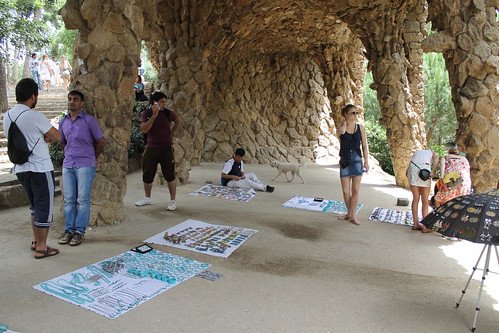
It was also fairly crowded with tourists — we heard French or German as often as we did English, and on a hot day, Park Guell seemed less like the retreat from the city Gaudi had originally envisioned it and more a cog in the great machine of Barcelona tourism. However, Steve, Lele, and I all managed to roam around the park enjoying the intriguing terraces, pillars, and houses of Gaudi’s genius.
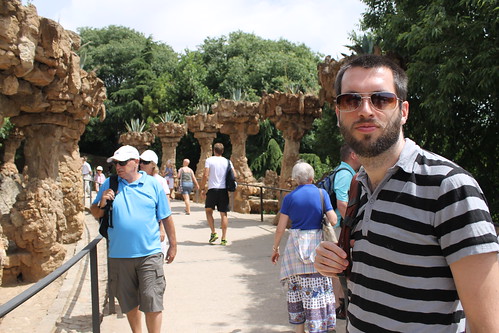
We had a better experience with our second stop on the grand tour of Gaudi, which is the world-famous Sagrada Familia, or the Church of the Holy Family. Gaudi took over design and building on this iconic structure, his life’s masterpiece, in 1883. By the time he died in 1926, only a few parts of the church were completed, but since then, much more has been done, though it is famously still a work-in-progress. Part of that is due to funding in the past hundred years, but the other part is certainly that Gaudi’s design and vision vastly exceeded the technological capabilities of his day. Even with modern building technologies, the cathedral is still slated to be completed by 2026 for the centenary of his death. We bought tickets two days ahead of time to visit the cathedral and also to climb the famous towers at a pre-established time.
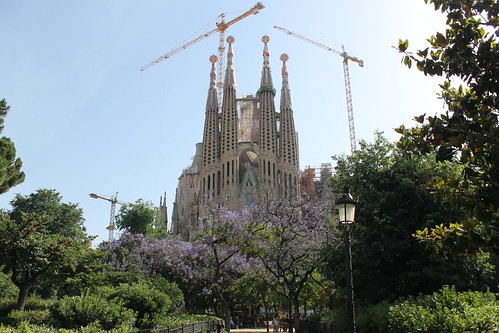
When we arrived at 9:30 am after a brisk walk from our apartment, we found the entire structure entirely awash in tourists, with a line that wrapped around the city block for tickets. Entirely too grateful for our foresight, we slipped in ahead of everyone else and wandered about the church for an hour before taking a lift to the towers. The first thing Steve said when he entered was, “Is this a church or a mall?” Having seen literally a dozen cathedrals since we arrived in Europe this spring, we found the Sagrada Familia very different and very difficult to fit into our existing catalogue of cathedrals. It is undeniably beautiful and very modern. The outside looks like a dripsand castle, Gaudi’s naturalist tendencies showing through very clearly, and the inside like a forest, with many pillars and columns that grow toward the ceiling like trees. There is a very polished quality also about the interior, which is illuminated by abstract stained-glass windows, which are likewise still being filled in bit by bit.
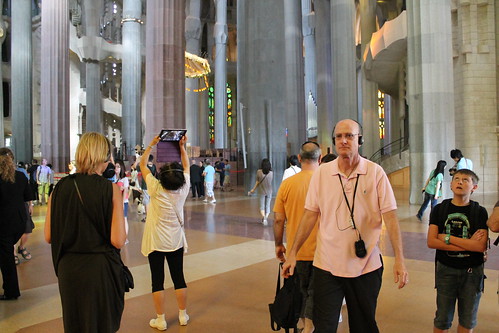

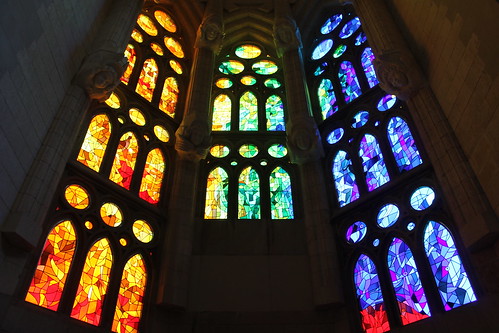
There are two facades currently mostly finished, the Nativity (describing the early life of Christ) to the east and the Passion (describing the death and resurrection) to the west. The Glory facade to the north is to be the biggest and has not even been begun. That should give you an idea of the scale of Gaudi’s vision. We did get to see the Nativity and Passion facades, both of which are very striking and different. The Nativity is more like a dripsand castle, with very grand typically Gothic sculptures and scenes; in contrast, the Passion facade, which we got to see in close detail, had stark, geometric sculptures which felt very harsh but nonetheless very impressive. It left a deep impression on me. Finally, we took an elevator up the Passion facade, inside one of the four towers, and got a lovely view of Barcelona to the west as well as a close-up glimpse at the architecture of the tower and the continuing progress being made on the cathedral.
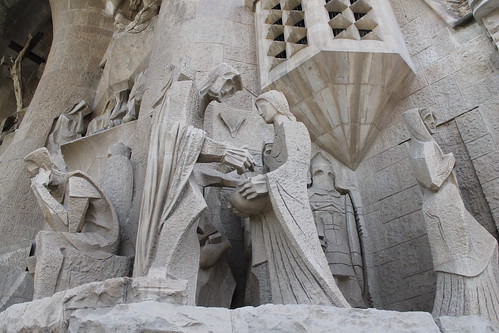
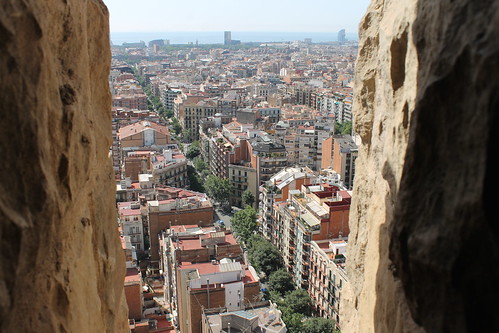
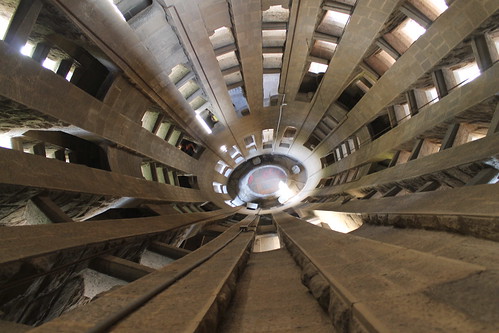
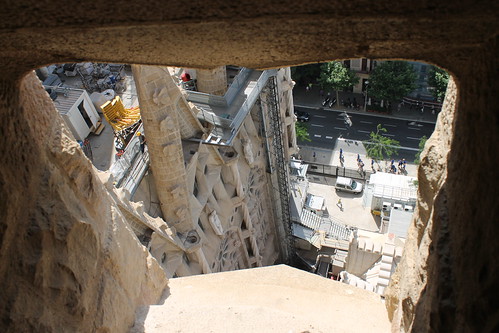
We concluded our visit with a short tour of the crypt, parts of which have been turned into a small museum with scale models of the church, plans and drawings of the art, photographs of the work-in-progress a century ago, and details about Gaudi’s life. Gaudi himself lies interred in the crypt. Seeing those exhibits which were just as packed with people helped clarify some of our thoughts about the Sagrada Familia. The main failing of the church is that it is not really a house of worship, but simply an architectural and historical monument. Many cathedrals and churches succeed at being both, but the Sagrada Familia lacks the touches that I find most interesting and moving about visiting a historical church: those signs of an active faith and congregation like candles lit at the chapels or worn hymnal books. Buildings of historical significance for me ought to really bear the grimy mark of history, unlike this polished, very stand-offish masterpiece. On the other hand, maybe it’s not fair to judge this cathedral on these merits since it’s not even finished, and has only been used for services since 2010. We found it a beautiful and impressive stop on our tour of Barcelona, but as I remarked to Steve when we left, it was much less a monument to God and more a monument to Gaudi.
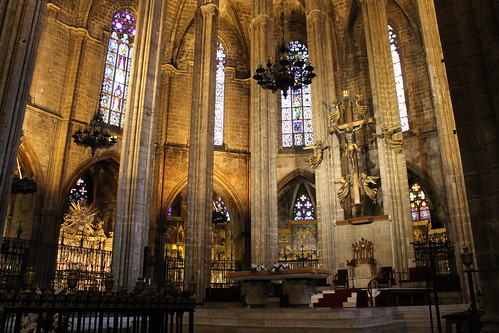
Later that day, our last full day to Barcelona, Steve and I also made a trek to the Barcelona Cathedral in the Old City to see that. This structure fell more in line with our expectations, and was lit in a lovely way on the inside. It featured an altar as well as a chapel to Saint Lucy or Lucia, the patron saint of the blind. Steve noted that she is also considered the patron saint of optometry, so we lit candles to her on behalf of Steve’s family. The cathedral also had a noted cloister which holds several very old fountains kind of like the sort we found in Aix-en-Provence, as well as thirteen white geese, which are fond of eating whatever tourists throw them and also making an unholy mess. I don’t understand, but apparently, it’s tradition.
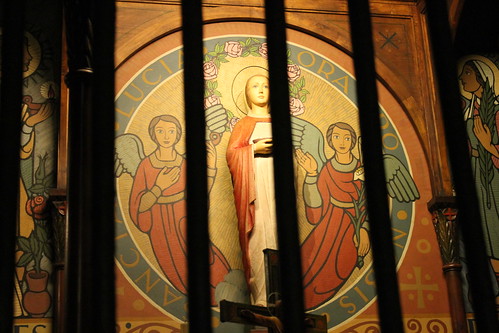
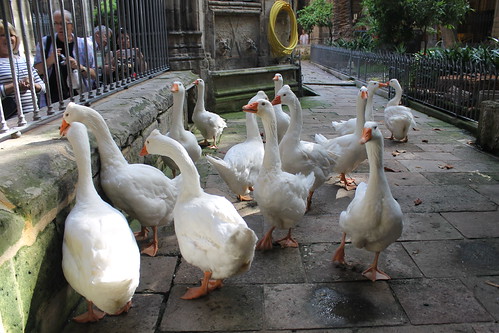
Finally, we ended our last day by all going out together for dinner in Gràcia once more. We visited Gaseteria, a tapas and pinxhos joint which was extraordinarily affordable and tasty! Highlights included the fig and cheese, a mini-hamburger which both Steve and Lele ordered double-helpings of, and my personal favorite, roasted green peppers which looked like they ought to have been toxically spicy, but were simply succulent and delicious.
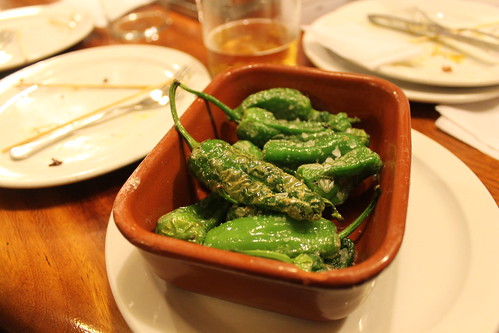
The next morning, we hustled to the airport and flew out to Paris. Overall, Barcelona was quite a touristy city, which we ought to have expected. At Park Guell, we saw sprayed graffiti saying “TOURISTS GO HOME” and also some flyers by associations of local residents protesting how the Barcelona city government has developed this park as a tourist destination, making conditions difficult for the actual people who live here, and arguing for the entire park to be opened up free of charge. From a personal perspective, I would much rather live in a place that is unremarkable in every way, because I value comfort, affordability, and convenience over social cachet, fashionableness, and historical significance. Thanks, but no thanks, NYC. So I sympathize strongly with the people who live around here. From a public policy point of view, the city has a tough line to walk no matter what. When faced with this sort of conundrum, governments tend to let the money do the talking, and the promotion of tourism usually supercedes the needs of the locals. That’s why I think there needs to be an emphasis on the needs of its residents and the preservation of the authenticity of its culture. Will people still visit Barcelona if it’s not Barcelona anymore? Though I loved the overall atmosphere of the city, I would not suggest most of the places we visited to other travelers, partially because of how these places have been managed but also partially because it doesn’t seem like it’s really a part of the city and country that we are trying to get to know. In that vein, the Great Wall is a poor place to visit if you want to learn about what China is really like, and Times Square does a horrible job of standing in for the whole of America. However, it’s hard to say whether this is the rule or the exception, because we’ve seen quite a few iconic sights that contribute rather than detract from our entire experience, which I’ll get to write about soon.
Next stop, Paris…
Connie
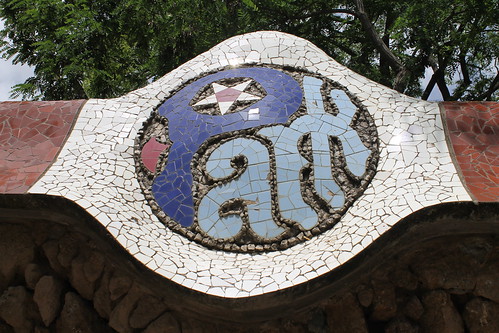
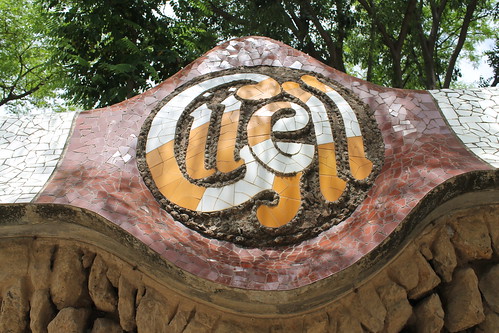
Many thanks for the candle lit at St. Lucy’s altar. <3